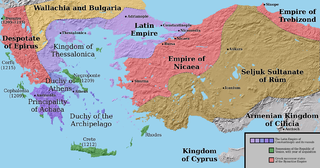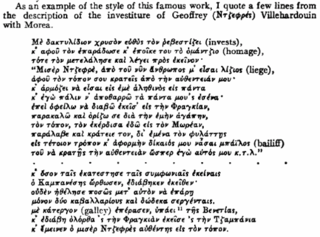Hugh I of Charpigny was a French Crusader and the first (or possibly second) Baron of Vostitsa in the Principality of Achaea.

The Fourth Crusade (1202–1204) was a Latin Christian armed expedition called by Pope Innocent III. The stated intent of the expedition was to recapture the Muslim-controlled city of Jerusalem, by first conquering the powerful Egyptian Ayyubid Sultanate, the strongest Muslim state of the time. However, a sequence of economic and political events culminated in the Crusader army sacking the city of Constantinople, the capital of the Greek Christian-controlled Byzantine Empire.

The Principality of Achaea or of the Morea was one of the three vassal states of the Latin Empire which replaced the Byzantine Empire after the capture of Constantinople during the Fourth Crusade. It became a vassal of the Kingdom of Thessalonica, along with the Duchy of Athens, until Thessalonica was captured by Theodore, the despot of Epirus, in 1224. After this, Achaea became for a while the dominant power in Greece.
The Barony of Vostitsa was established ca. 1209, after the conquest of the Peloponnese by the Crusaders, and was one of the original twelve secular baronies within the Principality of Achaea. The barony, with eight knight's fiefs attached to it, was given to the Charpigny family, of which Hugh is commonly held to have been the first baron. [1] [2] The family is obscure, however, and the exact origin of Hugh is disputed due to the differing attestations of his name in the main source, the various versions of the Chronicle of the Morea . The Greek version gives his surname as "de Lele", which has been commonly interpreted as being a corruption of "de Lille", and claims that he adopted the surname "de Charpigny" afterwards; while the Aragonese version of the Chronicle mentions that the first baron of Vostitsa was Guy, that Hugh was his son, named "Cherpini" after the Greek village where he was born (which some authors identify with Kerpini), and "Lello" was the name of a fortress constructed on the family's domains in Laconia (possibly Helos); to further complicate matters, the toponym "Charpigny" is not attested in contemporary France. [3] Whatever its origin, the family used the surname "Charpigny" in Greece; and Hugh was succeeded by his son Guy (II?). [4]

The Barony of Vostitsa was a medieval Frankish fiefdom of the Principality of Achaea, located in the northern coast of the Peloponnese peninsula in Greece, centred on the town of Vostitsa.

The Peloponnese or Peloponnesus is a peninsula and geographic region in southern Greece. It is connected to the central part of the country by the Isthmus of Corinth land bridge which separates the Gulf of Corinth from the Saronic Gulf. During the late Middle Ages and the Ottoman era, the peninsula was known as the Morea, a name still in colloquial use in its demotic form.

The Chronicle of the Morea is a long 14th-century history text, of which four versions are extant: in French, Greek, Italian and Aragonese. More than 9,000 lines long, the Chronicle narrates events of the Franks' establishment of feudalism in mainland Greece. West European Crusaders settled in the Peloponnese following the Fourth Crusade. The period covered in the Chronicle was 1204 to 1292. It gives significant details on the civic organization of the Principality of Achaia.

